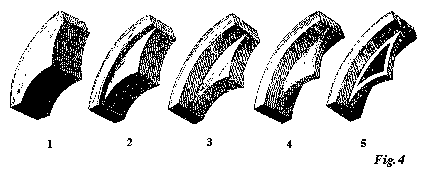CUSPS 10. FINAL APPENDIX 287
desire to obtain horizontal pressure. In all the Gothic staircases with which I am acquainted, out of Venice, in which vertical shafts are used to support an inclined line, those shafts are connected by arches rising each above the other, with a little bracket above the capitals, on the side where it is necessary to raise the arch; or else, though less gracefully, with a longer curve to the lowest side of the arch.
But the Venetians seem to have 
It will be noted, in Plate 11, that the form and character of the tracery bars themselves are independent of the position or projection of the cusps on their flat sides. In this respect, also, Venetian traceries are peculiar, the example 22 of the Porta della Carta being the only one in the plate which is subordinated according to the Northern system. In every other case the form of the aperture is determined, either by a flat and solid cusp as in 6, or
 |
by a pierced cusp as in 4. The effect of the pierced cusp is seen in Plate 18, Vol. II.; and its derivation from the solid cusp will be understood, at once, from the woodcut above, Fig. 4, which represents a series of the flanking stones of any arch of the fifth order, such as f in Plate 3, Vol. I.
The first on the left shows the condition of cusp in a perfectly simple and early Gothic arch, 2 and 3 are those of common arches of the fifth order, 4 is the condition in more studied examples of the Gothic advanced guard, and 5 connects them all with the system of traceries. Introducing the common
[Version 0.04: March 2008]